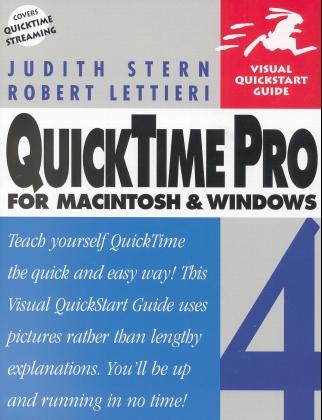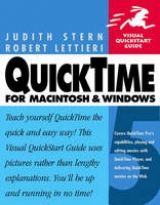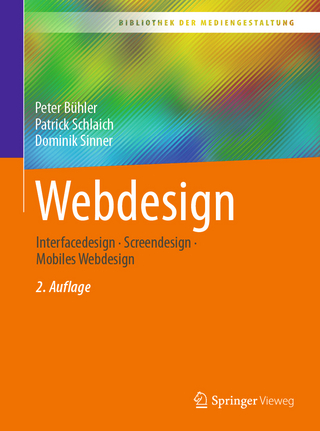
QuickTime Pro 4 for Macintosh and Windows
Addison Wesley (Verlag)
978-0-201-35469-0 (ISBN)
- Titel erscheint in neuer Auflage
- Artikel merken
Whether you're new to multimedia ora seasoned author, QuickTime Pro 4: Visual QuickStart Guide will have you up and running fast with Apple's award-winning, cross-platform multimedia package. This step-by-step guide walks you through QuickTime 4, QuickTime Player Pro, and all the latest components, with in-depth coverage of QuickTime 4's new true streaming feature.
Written for the beginner and advanced user alike, QuickTime Pro 4: Visual QuickStart Guide gives you straightforward explanations of the features you'll find in the Professional edition of the package, including its extensive editing tools and newfound ability to import MP3 and Flash files. Informative screenshots are sprinkled liberally throughout the book to help keep you on track as you work.
Introduction. 1. QuickTime Basics. Differences Between the Pro and Standard Editions. Checking for QuickTime 4. Checking for the Pro Edition. Hardware and Software Requirements. Obtaining and Installing QuickTime 4. Upgrading to QuickTime 4 Pro. Getting QuickTime Updates and Missing Components. Finding Sample Movies. About the QuickTime Interfaces. 2. The QuickTime Standard Controller. Playing and Pausing Movies. Stepping Through a Movie Frame by Frame. Randomly Accessing Points in a Movie. Changing the Audio Level. Overdriving Audio. Varying a Movies Playback Rate. Using Chapter Lists. Saving Movies on the Web. 3. QuickTime Player Basics. About the QuickTime Player Window. Opening QuickTime Movies. Opening Non-QuickTime Files. Converting Non-QuickTime Files. Opening Files on the Internet. Opening Favorites. Adding and Organizing Favorites. Changing Window Sizes. Showing Copyright Information. The Info Window. Determining Which Tracks a Movie Contains. About Preferences. 4. Controlling Movies in the Player. Playing and Pausing Movies. Changing the Audio Level. Randomly Accessing Points in a Movie. Stepping Through a Movie Frame by Frame. Fast-Forwarding and Fast-Reversing a Movie. Changing Balance, Bass, and Treble. Presenting a Movie. Presenting a Movie Frame by Frame (in Slide-Show Mode). Looping a Movie or Playing It Backward. Playing Every Frame. Playing and Pausing All Open Movies. Checking the Frame Rate. Using Chapter Lists. Choosing a Language for Playback. Searching a Text Track. 5. Interacting with QuickTime VR. Looking Around in Panorama Movies. Manipulating Objects in Object Movies. Finding and Using Hot Spots. Zooming In and Out. Moving Zoomed-In Objects. Presenting QuickTime VR Movies. 6. Basic Movie Editing. Selecting and Deselecting Movie Data. Jumping to the Beginning or End of a Selection. Playing Only Whats Selected. Fine-Tuning a Selection. Getting Time Information about the Movie and Selection. Copying and Cutting Movie Data. Having Multiple Windows Open in QuickTime Player. Pasting Movie Data into a Movie. Pasting Text and Graphics into a Movie. Creating a New Movie and Pasting. Movie Data into It. Combining Two Movies. Deleting Parts of a Movie. Replacing Part of a Movie with a Portion of Another. Drag-and-Drop Editing. Adding and Editing Annotations. Changing Whats Shown in the Info Tray. Setting a Poster. Setting a Preview. Setting a Preview Using Data from Other Movies. Saving Movies. Checking File Dependencies. 7. Working with Tracks. Combining Tracks with the Add and Add Scaled Commands. Extracting Tracks. Deleting Tracks. Disabling and Enabling Tracks. Scaling a Track to a Specific Duration. Setting Up Tracks with Alternate Languages. Specifying a Language for a Track. Designating a Set of Alternate Tracks. Loading Tracks into Memory. 8. Working with Visual Tracks. Flipping, Rotating, Resizing, and Skewing. Masking a Visual Track. Placing Visual Tracks Side by Side. Creating a Picture-in-a-Picture Effect. Relayering Tracks. Making a Color Transparent in a Track. Blending Tracks. Using Alpha Channels. Adding Visual Data to QuickTime VR Movies. Adding a Custom Color Table to a Movie. Creating a Still-Image File from a Movie Image. Creating a Set of Still Images from a Movie. Creating a FLC Animation from a Movie. 9. Video and MPEG Tracks. About Video Compression. About the Compression Settings Dialog Box. Determining How a Video Track. Was Compressed. Creating Video Tracks from a Sequence of Still Images. Creating a Video Track from a Single Still Image. Creating Video Tracks from Non-QuickTime Animation and Video Files. Adding Images to an Existing Movie. Creating MPEG Tracks from MPEG Files. 10. Text Tracks. Creating a Text Track by Importing a Text File. Specifying Text Track Appearance when You Import. Specifying the Duration and Appearance of Individual Frames of Text. Exporting a Text Track with Text Descriptors and Time Stamps. Creating a Text Track Thats Synced to Other Tracks. Changing Text Thats Already in a Text Track. Adding Small Amounts of Text. Creating Chapter Lists. 11. Sprite, 3D, and Flash Tracks. Attaching a Graphic or Video Sequence to a Sprite. Changing the Background Color of a Sprite Track. Changing Properties of Tracks with Wired Sprites. Creating a Static 3D Track from a 3D File. Changing Texture Mapping for a 3D Track. Changing the Renderer for a 3D Track. Creating Flash Tracks from Flash Files. 12. Working with Audio Tracks. Adding New Audio to a Movie. Adding a Still Image to an Audio Track. Having Audio Play When the Movie Isnt in Front. Changing the Default Volume, Balance, Bass, and Treble of an Audio Track. 13. Sound Tracks and MPEG Audio Tracks. About Digitized Sound. About the Sound Settings Dialog Box. Checking the Characteristics of a Sound Track. Creating a Sound Track from a Sound File. Creating a Sound Track from an Audio CD. Creating an MPEG Audio Track from an MPEG Sound File. Changing the Characteristics of a Sound Track. Converting a Music Track to a Sound Track. Using QuickTime Player as a Sound. Conversion Utility. 14. Music Tracks. Converting MIDI Files to QuickTime. Converting Karaoke Files to QuickTime. Changing Instruments in a Music Track. Substituting Your Own Custom Sound for an Instrument in a Music Track. Playing Music Tracks Through a MIDI Synthesizer. Converting Music Tracks Back to MIDI. 15. Delivery Basics. About Data Rate and Size. Checking Data Rate and Data Size. Saving Movies for Distribution. Exporting Movies as QuickTime Movies. Applying Filters. Compressing Selected Tracks. Overview of Authoring and Presentation. Tools That Support QuickTime. Checking the Dimensions of a Movie. 16. QuickTime on the Internet: Basics. About Streaming. RTSP Vs. HTTP Streaming. Preparing Movies for HTTP Streaming. Preparing Movies for RTSP Streaming. Preparing Movies for Mixed RTSP and HTTP Streaming. Choosing Video Compression Settings. Choosing Sound Compression Settings. Embedding an HTTP QuickTime Movie on a Web Page. Embedding an RTSP QuickTime Movie on a Web Page. 17. QuickTime on the Internet: Advanced. Adding Attributes to Your EMBED Tag. Creating a Small Movie to Use as a Poster Movie. Writing the HTML for a Poster Movie. Making an Internet Movie Appear in QuickTime Player. Using HREF Tracks to Make Movies. Load Web Pages. Creating Hyperlinks in a Text Track. Forcing QuickTime to Open Files. Obtaining Important Utilities. Creating Alternate Movies. Storing Plug-In Settings in a Movie. Specifying Web Pages to Load When a User Clicks in a Movie. Putting Movies on the Internet That Cant Be Saved. Creating Streaming VR Movies with QTVR Flattener. Creating Panorama Thumbnails with QTVR PanoToThumbnail. 18. Movies on CD-ROM, Kiosk, and Videotape. Preparing Movies for CD-ROM and Kiosk. Video Compression Choices for CD-ROM. Sound Compression Choices for CD-ROM. Compression Choices for Kiosk. About Additional Compressors. Licensing Requirements for Distributing QuickTime. Outputting to Videotape. Appendix A: Mouse and Keyboard Tricks. Appendix B: Configuring QuickTime. Using the QuickTime Settings Control Panel. Using the QuickTime Plug-in Settings. Dialog Box. Appendix C: Resources. Index.
| Erscheint lt. Verlag | 13.9.1999 |
|---|---|
| Verlagsort | Harlow |
| Sprache | englisch |
| Maße | 178 x 229 mm |
| Gewicht | 584 g |
| Themenwelt | Mathematik / Informatik ► Informatik ► Grafik / Design |
| Mathematik / Informatik ► Informatik ► Web / Internet | |
| ISBN-10 | 0-201-35469-1 / 0201354691 |
| ISBN-13 | 978-0-201-35469-0 / 9780201354690 |
| Zustand | Neuware |
| Informationen gemäß Produktsicherheitsverordnung (GPSR) | |
| Haben Sie eine Frage zum Produkt? |
aus dem Bereich



